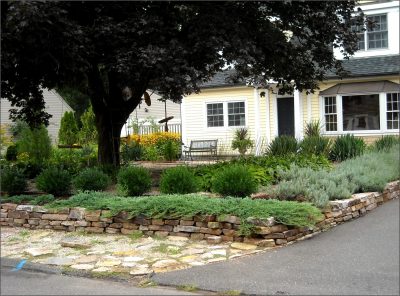By Pamm Cooper, UConn Home & Garden Education Center

The trend in North America of having a lawn surrounding a house is not a world-wide one. As a matter of fact, it’s only since the 1940s that American lawns took a turn toward a neat, manicured, park- like atmosphere. Almost every house that is built today features a lawn and some type of decorative plantings. Shrubs are planted along the foundations of houses, and often an ornamental tree or two are strategically planted to accent the landscape. It creates the idea of a little park surrounding every home, accented with walls, decks or a patio according to individual preference.
Sometimes it is desirable to reduce lawn areas, especially when an acceptable turf grass stand cannot be maintained without a great deal of expense or work. A lawn is not like a garden that can be tilled over and started anew when things turn out poorly. A lawn is intended to be a permanent part of the landscape. Problem areas that chronically fail to produce the desired dense stand of turf grass may need to be converted into something else. The idea should be to look at the home landscape as a property, and not necessarily as a lawn.
The best way to begin determining what may look better on your property may be to take a drive around your area and see what other people have done. This is especially helpful when dealing with shade problems where grass can’t be grown so that it fills in properly. Sometimes homeowners have limbed up trees, like oaks or maples, to allow enough sun to grow a suitable stand of grass. Some people have given up and may have tried some other type of planting. As an example, Flowering Dogwoods are native trees which do best planted beneath taller trees with no grass or other plant within three feet of their trunk. Sometimes you see ground covers planted around the bases of trees, filling in up to the point where grass can form an acceptable dense stand.
There are some properties that have no lawn areas at all. Instead, perennial flowers, ornamental grasses, shrubs, and walkways are incorporated sometimes with a grass walkway. Almost any plants and trees can be selected if they are suitable for our climate zone and soil type. Keep in mind, though, that there may be quite a bit of maintenance involved in any landscape planting. Even low maintenance plants may need to be pruned or divided periodically.
Modified mowing is another way to reduce lawn area. This works especially well where there is a large area that can be left uncut for most of the year. In spring, before letting the grass grow, a wildflower mix suitable for the site can be scattered in. Or the grass can just be left alone and mowed down in the spring or fall to keep it tidy and prevent trees from getting established. Often the uncut area is contoured to enhance a driveway or other feature.
A lawn can drastically affect one’s enjoyment of one’s home landscape. Turf can be looked at as more of a “floor of a garden,” rather than as the focus of the property. If having a great looking lawn is out of reach, consider alternatives that can enhance both the visual appearance of your home and the overall enjoyment of being at home. Where a lawn constantly struggles, do not hesitate to consider planting something else. It will help lessen the load of things to worry about.
For questions about lawns, lawn alternatives or other gardening questions, feel free to contact us, toll-free, at the UConn Home & Garden Education Center at (877) 486-6271, visit our website at www.homegarden.cahnr.uconn.edu or contact your local Cooperative Extension center.
This article was published in the Hartford Courant Jan. 25, 2025